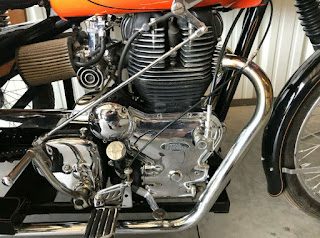 |
| Once purely a utility vehicle, this 1958 Indian Patrol Car became a Royal Enfield hot rod. |
Dubbed "The Royal Rickshaw," this custom tricycle motorcycle was featured in the February, 1973 edition of Custom Chopper magazine.
According to the eBay ad it "is a one-off work of art from Southern California in the early '70s."
"Buy It Now" price is $6,995.
 |
| The big Royal Enfield Interceptor motor dominates the look of this custom tricycle. |
Patrol Cars were also used by traffic police officers and meter maids.
 |
| Hand-shift quadrant puts Neutral all the way back. There is no reverse. |
(Overall gearing would have been reduced to compensate for the loss of first gear, making the Patrol Car — originally powered by a 350cc Royal Enfield single — very slow. The 750cc twin-cylinder Interceptor motor must be quite an improvement.)
 |
| 1964 Royal Enfield Interceptor motor gleams. |
At the time, in Britain, a company named Pashley used Royal Enfield front-ends and motors to build tricycles for business use. One of these hybrids ended up, badged as an Indian Patrol Car, at an Indian dealership in San Diego, Calif.
 |
| The Patrol Car in as-found condition. |
It ended up in the back of the lot, and decay set in. It wasn't sold until Ed Thompson spotted it beneath a pile of junk, and become its first registered owner. Restoration and customization took four years.
As a custom with a highly polished motor, it started winning awards, and it comes with quite a collection of trophies.
 |
| Indian had a Patrol Car of its own to compete with the Harley-Davidson Servi-Car. What was "Completely New" was that now it would be a Royal Enfield at heart. |
The frame number BR015 on this Patrol Car "is a Pashley chassis number," according to Graham Scarth, chairman of the Royal Enfield Owners Club UK.
"Their records do not appear to have survived, so we don't know how many they made."
 |
| Royal Enfield enthusiasts will appreciate the "Shell Motors" license plate surround. Shell was a famous California distributor for Royal Enfield back in the day. |
But it sure is a looker. Hatfield Powersports can be reached at 480-848-1769. Here's a video of the custom Indian Patrol Car running. Note the operation of the foot throttle.
































No comments:
Post a Comment